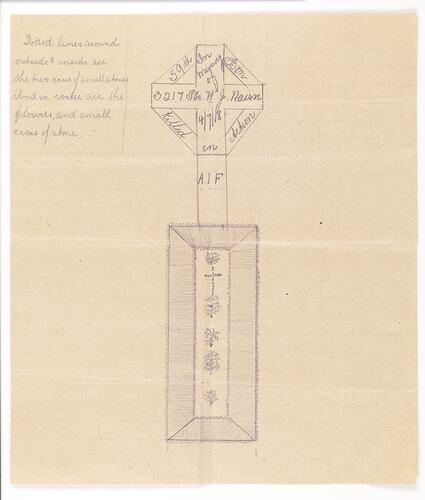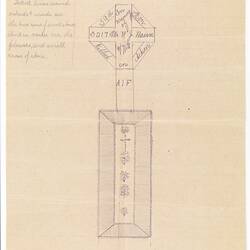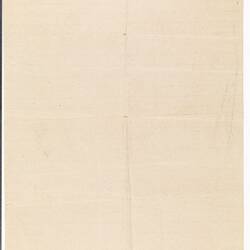Summary
Sketch of the grave of Private William Nairn on lined browned paper, with a description of its design. He was killed in France on 4 July 1918, during World War I. A photograph of William's grave was also donated with the collection (MM 140439).
William's place of death is variously recorded as Hamel (Roll of Honour), Villers-Bretonneux and Ville or Villiers sur Ancre (by fellow soldiers). His date of death coincides with the Battle of Hamel, which was commanded and led by John Monash and included William's 59th Battalion. William was buried by Rev. L.S. Couston at Vignacourt Military Cemetery, France.
Individual photographs and sketches of graves - often described as 'sacred' places - were sought by countless relatives as a way of connecting them with loved ones who had died in battle. They were provided by visitors or, more often, the Directorate of Graves Registration and Enquiries. Soon after World War I ended an Australian photographic section was established to undertake the task in a systematic manner. These early photographs typically depicted temporary wooden crosses erected over graves. In the 1920s the Imperial (later Commonwealth) War Graves Commission undertook the enormous task of re-burials into defined and ordered cemeteries, using standard headstones. William Nairn's burial site was changed to Mericourt L'Abbe Military Cemetery.
Physical Description
Sketch of grave on lined browned paper. Comprises cross with bars diagonally joining each side, mounted on a wider rectangular base with dotted cross and other floral motifs. A hand-written description appears at upper left of paper. The back of the paper is blank. It has been folded vertically and horizontal, creating creases.
More Information
-
Collecting Areas
-
Place & Date Depicted
-
Person Commemorated
Private William (Bill) J. Nairn - Australian Imperial Force (AIF), Ballarat, Victoria, Australia, circa 1919
-
Inscriptions
Hand-written: 'Dotted lines around / outside & inside are / the two rows of small stones / it and in centre are the / flowers, and small / cross of stone'. Written on cross: '59th / Btn / 3217 Pte. W. J. Nairn / 4/7/18 / Killed / in / Action / A.I.F.'
-
Classification
-
Category
-
Discipline
-
Type of item
-
Dimensions
180 mm (Width), 207 mm (Height)
-
References
NAIRN, William John - National Archives of Australia, barcode 7989771 First World War Red Cross Wounded and Missing files, William John Nairn, Australian War Memorial Family Notices. (1917, January 8). Geelong Advertiser (Vic. : 1859 - 1924), p. 1. Retrieved June 2, 2015, from [Link 1] Classified Advertising. (1920, November 17). The Argus (Melbourne, Vic. : 1848 - 1957), p. 16. Retrieved June 23, 2015, from [Link 2] Bart Ziino, A Distant Grief: Australians, War Graves and the Great War. University of WA Press, 2007
-
Keywords
World War I, 1914-1918, Military Memorabilia, Death & Mourning, Religions: Roman Catholic, Correspondence, Graves




